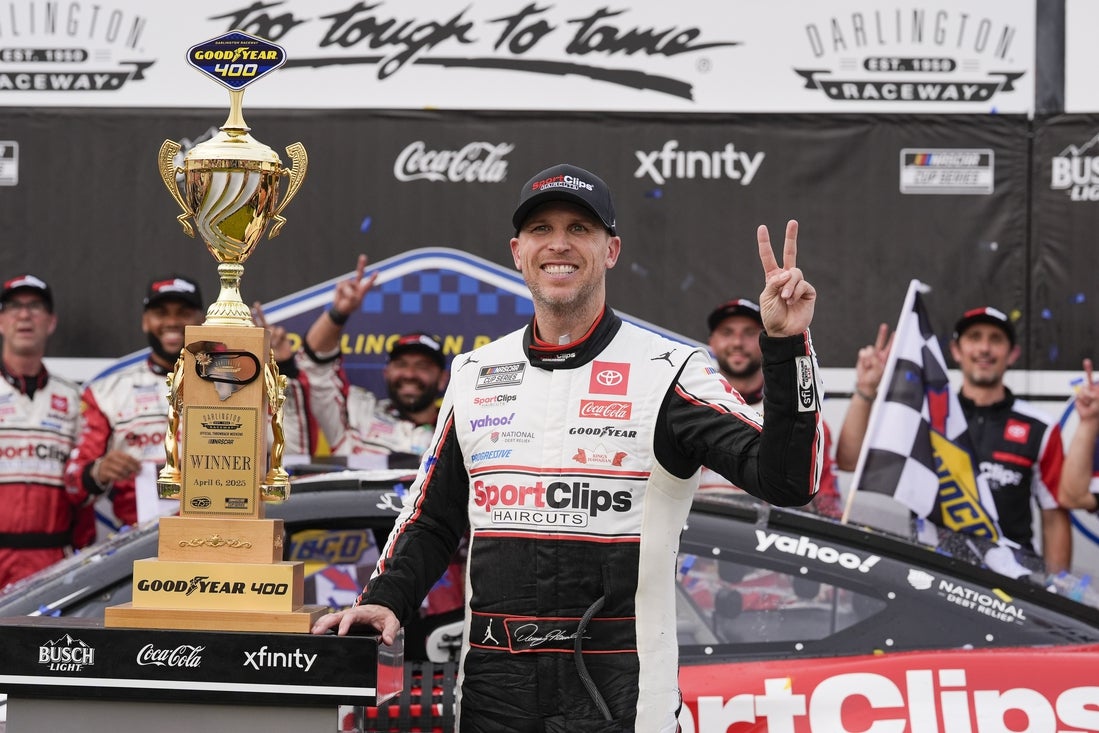
Denny Hamlin has the chance to reach a mark no NASCAR Cup Series driver has reached since all the way back in March — and despite the fact that only a month has gone by since it was last accomplished, it would be very impressive.
Christopher Bell’s three wins in a row at Atlanta, Circuit of the Americas and Phoenix Raceway may lighten the impact of what Hamlin could accomplish in Sunday’s Food City 500 at Bristol Motor Speedway, but make no mistake, winning three NASCAR races in a row is no small feat. If Hamlin crosses the line first, it would be his third consecutive win after he collected victories at Martinsville Speedway (March 30) and Darlington Raceway (April 6).
Bristol is the perfect venue for Hamlin to go for his third win in a row. In the four Next-Gen races held at “Thunder Valley,” Hamlin hasn’t finished worse than ninth. That four-race stretch includes wins in the 2023 Bristol night race and the 2024 Food City 500.
His finishes at Bristol before the current era vary on a wider scale, but there’s no denying that Bristol has been Hamlin’s playground with the Next-Gen car.
Hamlin has no short list of rivals threatening to end his winning streak at two.
Kyle Larson hasn’t finished worse than fifth at Bristol in the Next-Gen era. The winner of the 2024 Bristol night race is seeking history of his own this weekend, as he looks to be the first driver other than Kyle Busch to complete a triple sweep and win all three NASCAR races on a given weekend.
Hamlin won’t win a third consecutive race without competition from the last driver to win three in a row. Bell hasn’t finished worse than 10th in the four Bristol races with the Next-Gen car, and in eight races this season, he has five top-five finishes. After an uncharacteristically poor two-race stretch at Las Vegas and Homestead (12th, 29th), the No. 20 team bounced back with top-five finishes at Martinsville and Darlington.
Comparing Hamlin’s potential streak to Bell’s and the drivers that have won three in a row before them provides more context to Hamlin’s own run. In 2021, Larson won the Coca-Cola 600 at Charlotte, Sonoma and Nashville consecutively. Before Bell, he was the last driver to win three races in a row, and nearly made it four at Pocono before a flat tire on the final lap gave the win to Alex Bowman.
In 2018, Brad Keselowski won the Southern 500 at Darlington, the Brickyard 400 at Indianapolis and the Cup Series playoff opener at Las Vegas consecutively. Like the drivers that won three in a row after him, Keselowski found his three wins at three very different racetracks.
The bottom line? It’s hard to win three NASCAR Cup Series races in a row, especially in a modern era where the variety of the schedule puts different disciplines of racing on tap constantly. Only the best drivers can accomplish such a feat.
Just take a look at those who came before Keselowski, Larson and Bell. Jimmie Johnson won four Chase races in a row in 2007 en route to his second consecutive championship, while Mark Martin won four in a row in the summer of 1993. In 1992, Bill Elliott won four of the first five races of the season before ultimately falling just shy of the 1992 championship.
Hamlin’s resume and legacy already rival those whose feat he will try to match inside the “Last Great Colosseum” on Sunday, but winning three races in a row would just be another accolade on a long list of them for a man who is currently the best driver in NASCAR history to never win a Cup Series title.
–Samuel Stubbs, Field Level Media

